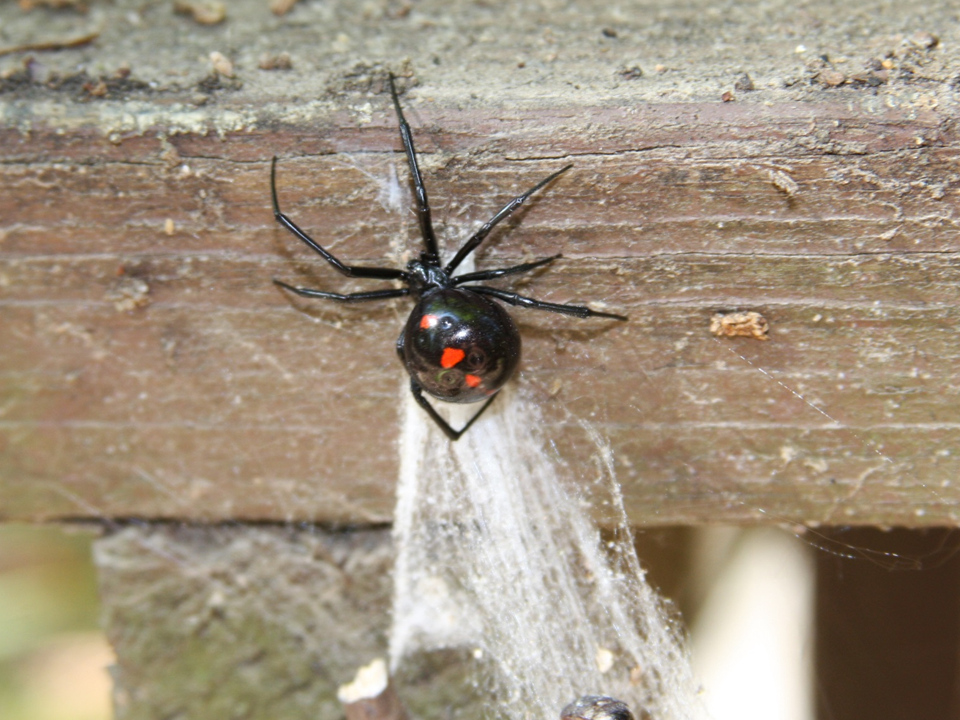Homeowners can take steps now to avoid large infestations
For the first time in about a decade, Kansas State University entomologist Jeff Whitworth is answering calls about the black widow spider.
“Right now, the black widow can be found around out-buildings, garages, old sheds and those areas,” Whitworth said. “And right now, of the one’s I’ve seen, they are producing egg cases.”
Listen to an interview by Shelby Varner with Jeff Whitworth on the weekday radio program, Agriculture Today
The female black widow is easily identified by a red hourglass shape on the underside of its black abdomen; the mature male is typically brown to blackish with red and black stripes. The spider gets its name from the popular belief that the female eats the male after mating – though that rarely happens in nature.
Folklore and Hollywood tell most people to be afraid of the black widow spider, but in reality, the spider is fairly timid. If disturbed, Whitworth said the female black widow is more likely to run away, though it tends to stay close to where it has laid its egg casing.
“If you hang around…they’ll act a little more aggressive,” Whitworth said. “They’ll rear up on their back legs. If you brush up against them or stand there for a minute, they may come out and actually bite you.”
A black widow spider bite is not likely to be fatal. Instead, a bite may be painful for 1-3 hours, and symptoms in humans may include fever, increased blood pressure, sweating and nausea. Seek medical attention if you believe you have been bitten by a black widow spider.
Perhaps more concerning to homeowners is the fact that the black widow spider can reproduce quickly. Whitworth said a single black widow female may produce up to four egg casings a year.
“And inside of each case may be 100 to 200 eggs, and when those hatch, you’ll have a whole bunch of little black widow spiders,” Whitworth said. “So, if you’re wanting to eradicate the black widow spider around your house or yard, now’s the time to go around and find them.”
Whitworth said the black widow produces a shabby-looking cobweb. “The best way to manage black widows is to make sure you carefully destroy any and all webbing and keep wood piles and other clutter away from the house,” Whitworth said.
If you find the egg case, he adds, destroy it by burning the casing, dousing it in alcohol, or even squashing it.
If a black widow spider drops on your body, avoid the temptation to smash it against your body; Whitworth says you may smash the spider’s fangs into your skin. Instead, flick the spider away and step on it, if you want to eradicate it.
“If you suspect you have been bitten by a black widow, contact your healthcare provider and show them the suspect if you can capture it safely,” Whitworth said.
Kansans are a little more familiar with another fairly shy spider – the brown recluse – which is also active right now.
“They’re laying eggs right now,” Whitworth said of the brown recluse. “They might make a little bit of a webbing, but for the most part, the brown recluse goes out searching for food from under or behind other objects, and from which there is often a small, loosely constructed web.”
The brown recluse seems to favor cardboard boxes and insulation inside buildings, and becomes more active as the weather gets warmer. “We’ve actually sampled and trapped hundreds of brown recluses in a building where we were doing research,” Whitworth said.
A brown recluse bite almost is never fatal to humans. Like the black widow, a brown recluse bite can be painful and cause an ulcerous wound, “but for the most part, you’re going to have to brush up to them or they’re going to have to fall on you…before they’re actually going to bite you,” according to Whitworth.
More information on black widow spiders and brown recluse spiders is available online from the K-State Research and Extension bookstore.
PHOTO: Black widow spiders seem to be more active this year, says K-State entomologist Jeff Whitworth. (Photo courtesy of K-State Department of Entomology)




